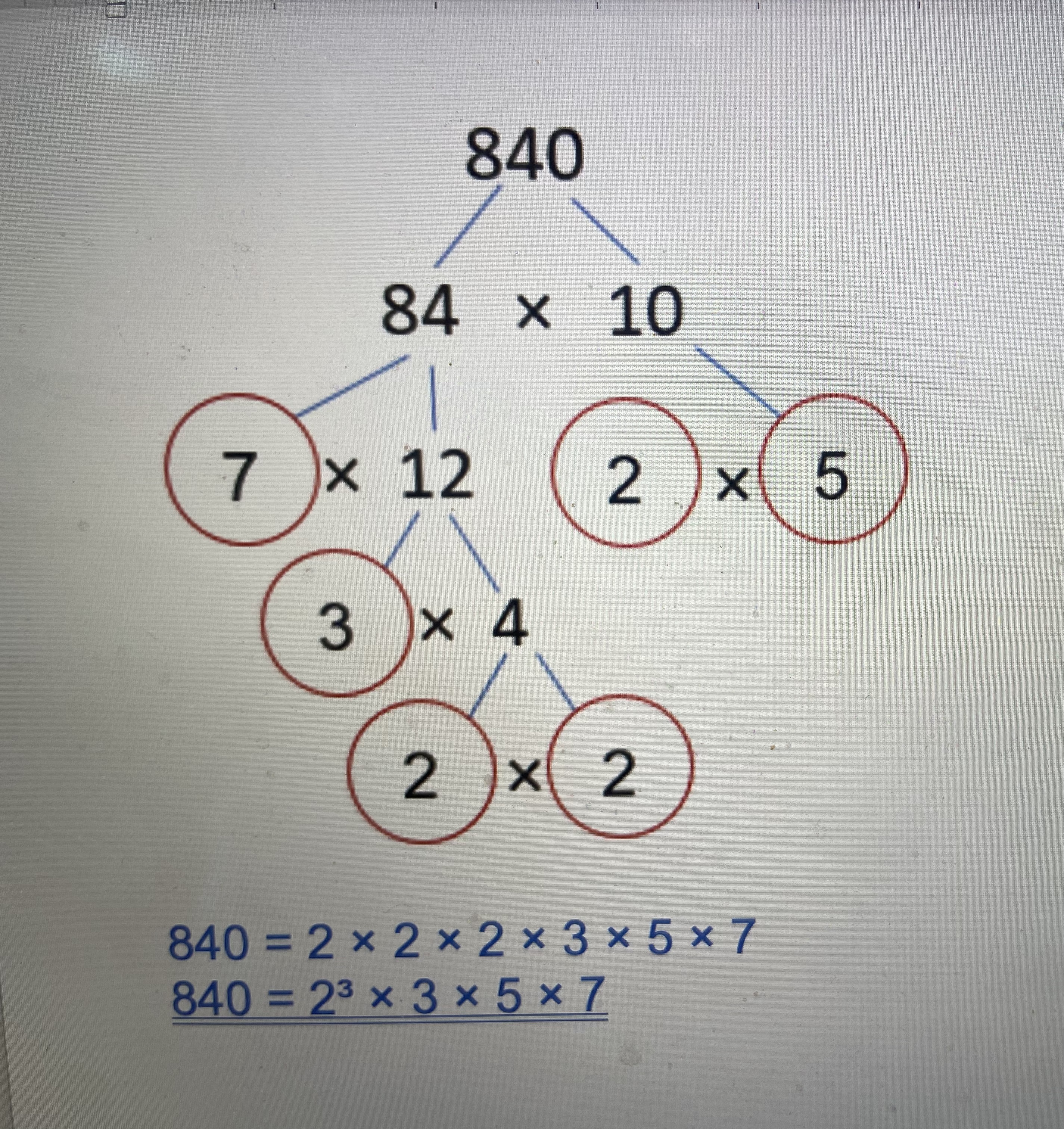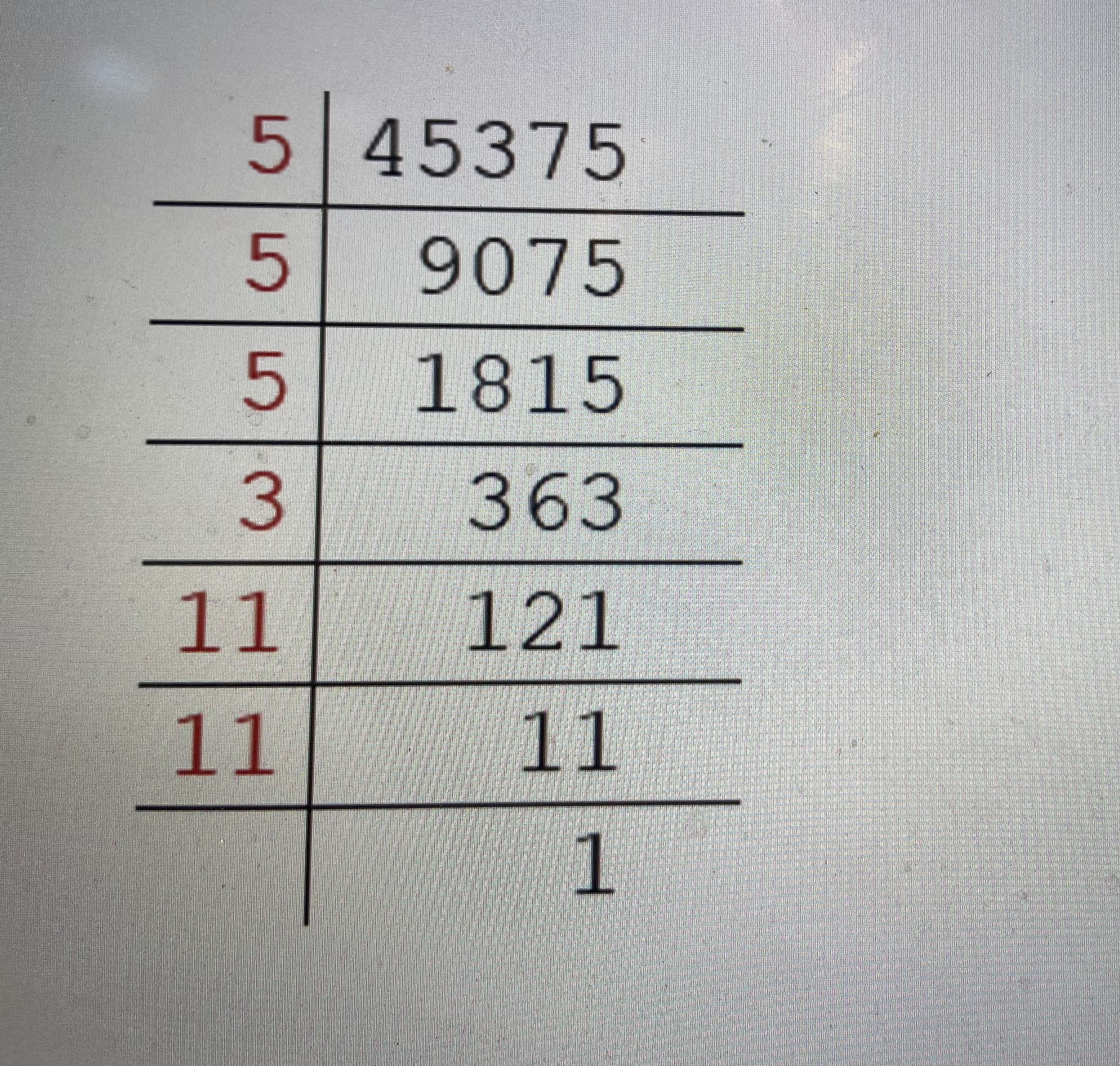- About Cargilfield
- Admissions
- Learning for the 21st Century
- Nursery
- Pre Prep
- Upper School
- Boarding
- News
- Essential Information
- Former Pupils
- Contact Us
One of the concepts the children are introduced to in Form 5 or 6 is that of prime numbers.
(There is a glossary of terms at the bottom of this blog).
So, the first few prime numbers are 2, 3, 5, 7 and 11
At Cargilfield, children usually start to work with prime numbers in Form 5 or 6. Once they have been introduced to them, they will learn to express other numbers as a product of their prime factors, e.g. 100 = 2 × 2 × 5 × 5 or 2² × 5²
One method of doing this is to use the factor tree, sometimes called the ‘cherry tree’. A number is gradually broken up until the prime numbers at its root are found and circled.
For example, express 840 as a product of its prime factors:

840 = 2 × 2 × 2 × 3 × 5 × 7
840 = 2³ × 3 × 5 × 7
Another method is called the ‘ladder’. This method is useful for numbers that do not as easily lend themselves to being broken up using mental arithmetic.
The way this works is a number is divided by prime numbers only until a final quotient of 1 is reached.
For example, express 45375 as a product of its prime factors:

45375 = 3 × 5 × 5 × 5 × 11 × 11
45375 = 3 × 5³ × 11²
Knowing the product of prime factors of a number has a wide range of applications.
Here are some ways the children might use the product of prime factors:
Given that 784 = 2⁴ × 7² and 1638 = 2 × 32 × 7 × 13, answer the following questions.
Whatever the level of application of product of prime factors, one essential ingredient to developing the children’s confidence is a fluent knowledge of times tables, not just the multiplication (7 × 9 = 63) but also the division too (63 ÷ 9 = 7).
Glossary of Terms
factor - A number that divides another number exactly. E.g. 6 is a factor of 18
multiple - A number which is part of another number's times table. E.g. 42 is a multiple of 7
prime number - A number which has exactly two factors. The number one and itself.
highest common factor - It is the largest factor common to a set of numbers. E.g. The HCF of 12 and 18 is 6
lowest common multiple - It is the smallest multiple common to a set of numbers. E.g. The LCM of 4 and 6 is 12
quotient - a result obtained by dividing one quantity by another.
Posted on
One of the concepts the children are introduced to in Form 5 or 6 is that of prime numbers.
(There is a glossary of terms at the bottom of this blog).
So, the first few prime numbers are 2, 3, 5, 7 and 11
At Cargilfield, children usually start to work with prime numbers in Form 5 or 6. Once they have been introduced to them, they will learn to express other numbers as a product of their prime factors, e.g. 100 = 2 × 2 × 5 × 5 or 2² × 5²
One method of doing this is to use the factor tree, sometimes called the ‘cherry tree’. A number is gradually broken up until the prime numbers at its root are found and circled.
For example, express 840 as a product of its prime factors:

840 = 2 × 2 × 2 × 3 × 5 × 7
840 = 2³ × 3 × 5 × 7
Another method is called the ‘ladder’. This method is useful for numbers that do not as easily lend themselves to being broken up using mental arithmetic.
The way this works is a number is divided by prime numbers only until a final quotient of 1 is reached.
For example, express 45375 as a product of its prime factors:

45375 = 3 × 5 × 5 × 5 × 11 × 11
45375 = 3 × 5³ × 11²
Knowing the product of prime factors of a number has a wide range of applications.
Here are some ways the children might use the product of prime factors:
Given that 784 = 2⁴ × 7² and 1638 = 2 × 32 × 7 × 13, answer the following questions.
Whatever the level of application of product of prime factors, one essential ingredient to developing the children’s confidence is a fluent knowledge of times tables, not just the multiplication (7 × 9 = 63) but also the division too (63 ÷ 9 = 7).
Glossary of Terms
factor - A number that divides another number exactly. E.g. 6 is a factor of 18
multiple - A number which is part of another number's times table. E.g. 42 is a multiple of 7
prime number - A number which has exactly two factors. The number one and itself.
highest common factor - It is the largest factor common to a set of numbers. E.g. The HCF of 12 and 18 is 6
lowest common multiple - It is the smallest multiple common to a set of numbers. E.g. The LCM of 4 and 6 is 12
quotient - a result obtained by dividing one quantity by another.
Posted on

Join us on Friday 2 May between 9am and 12pm to discover what makes Cargilfield truly special.